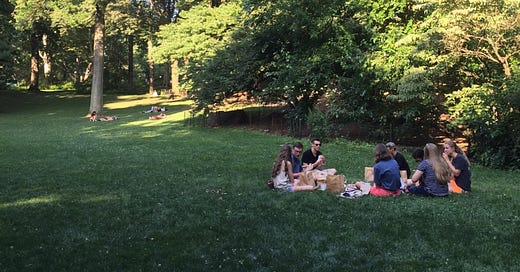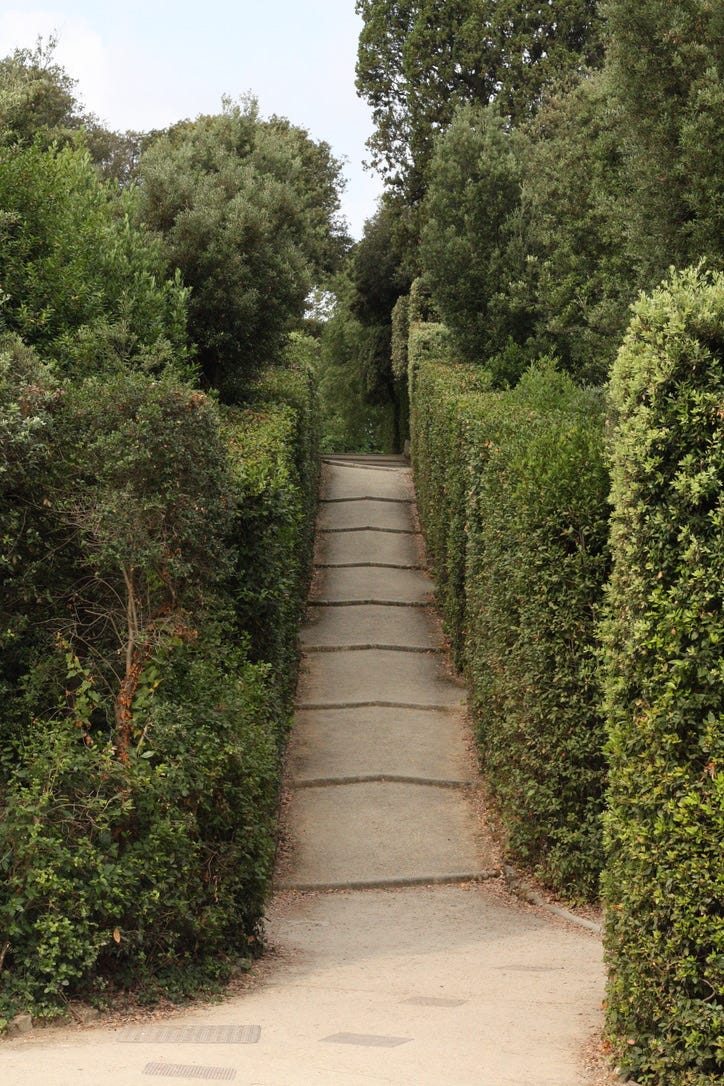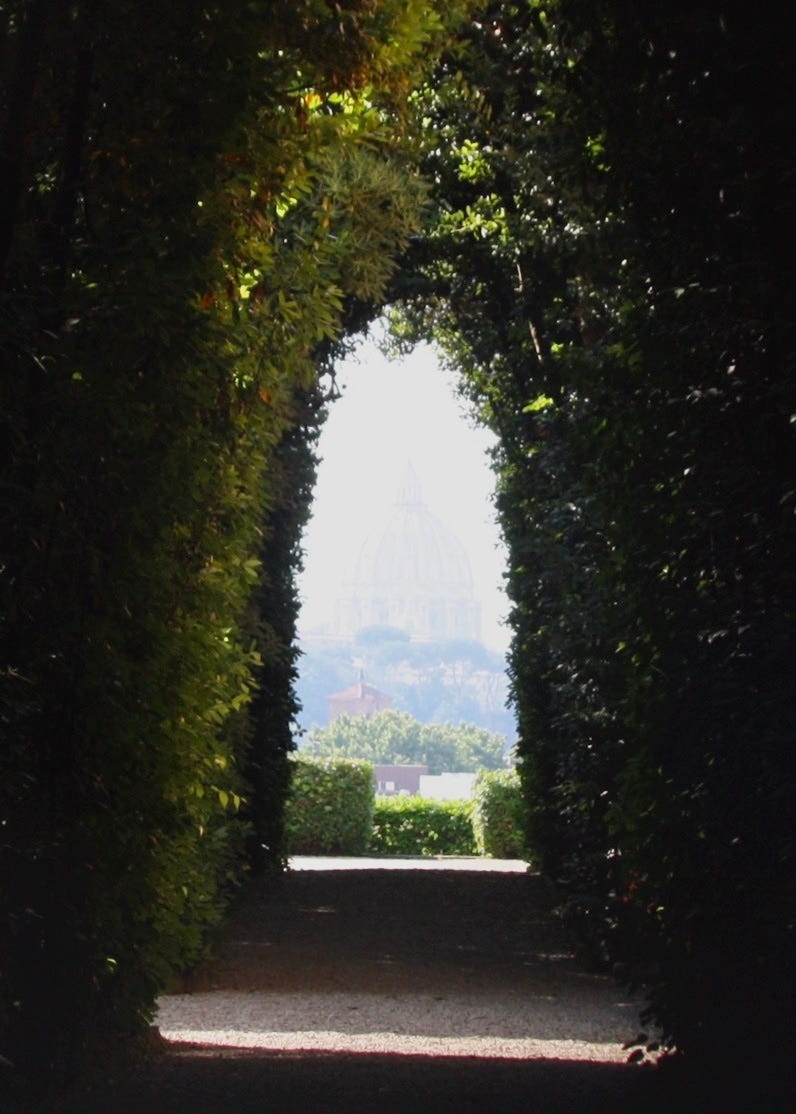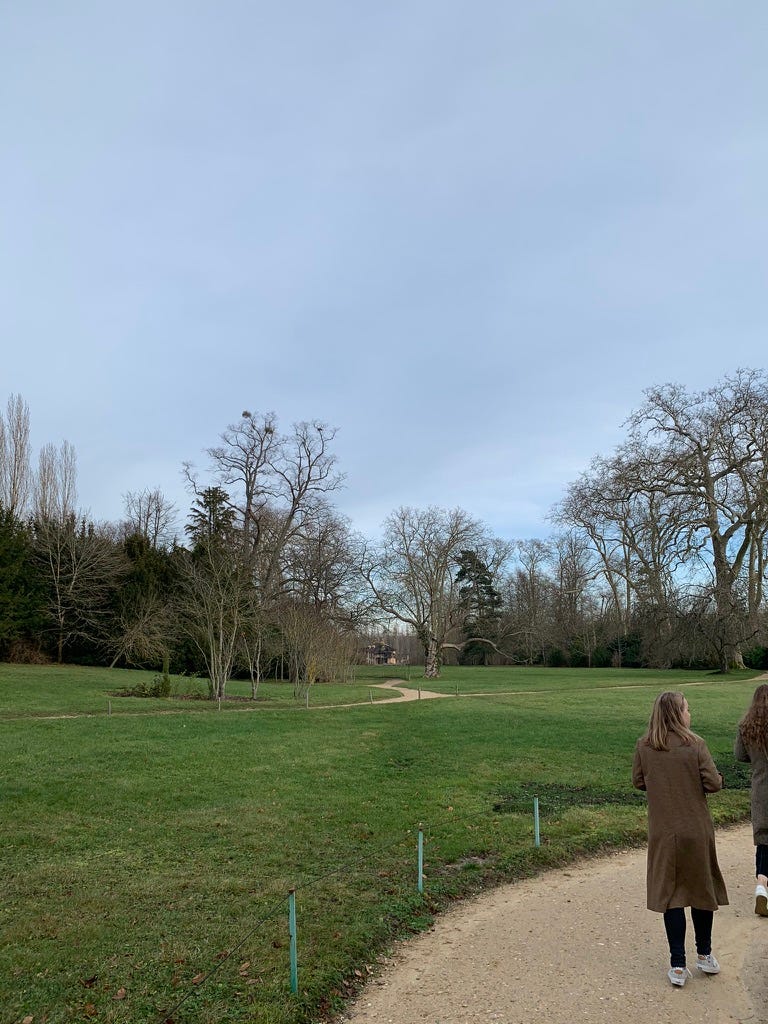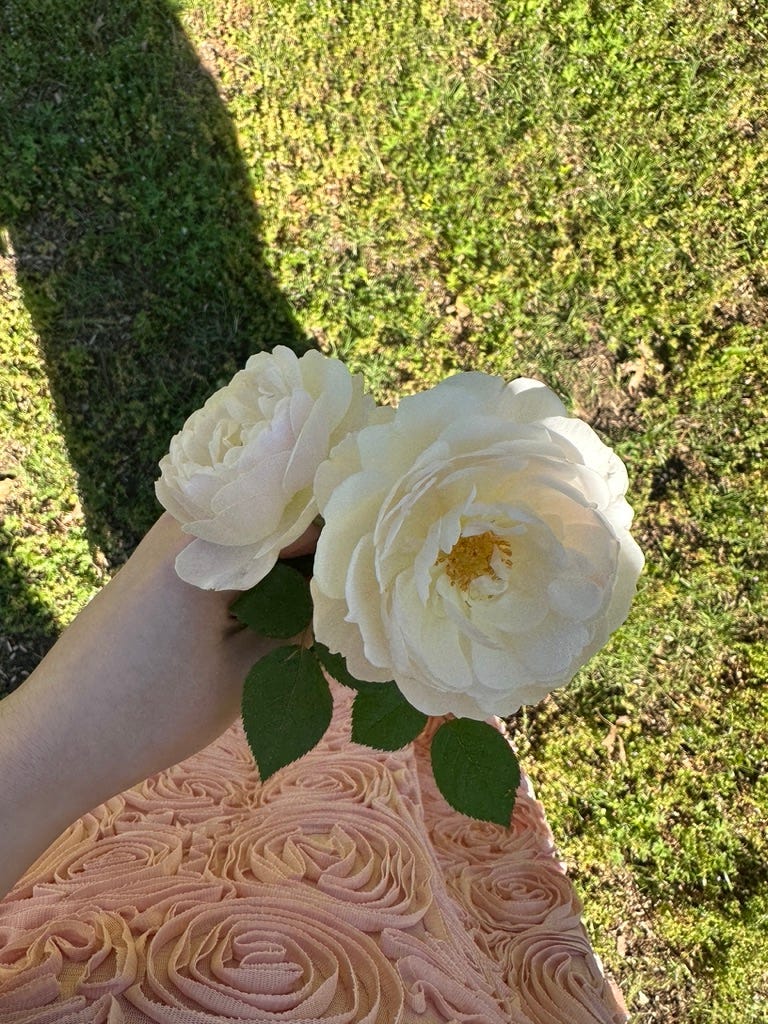Everything's coming up roses
An update on our garden, famous parks and gardens around the world, timeless garden design (as evidenced by celebrated designers), and the patio furniture I'm looking for.
ROOM TO GROW
Notes from our weekend spent in the garden
If there is any project to align with the concept of slow decorating, it is gardening. This is why: plants take time to grow! I know, a novel thought. José and I used the weekend to work in the garden. We spent a solid six hours simply preparing one flower bed, which was covered in an invasive vine that needed to be pulled up before we could plant anything new. We planted boxwoods, hydrangeas, a ground cover called liriope, and jasmine to climb up the columns of the porch. It took two full days of work.
When we finally stood back and admired our efforts, it looked so much better. We were proud.
But I had to laugh: the plants were so small!
I don’t know why it hadn’t occurred to me before we started all that gardening work that the small but healthy plants we were putting in the ground would not, in fact, be fully grown by the day’s end.
If you’ve never planted a garden, here’s a revelation: when you put young, new plants in the ground, you have to leave space for them to grow to their mature height. This means that at least for a year (but usually more), your plants will look a little curious until nature does its work.
There are many metaphors I could make here, but I will go with this one: life’s natural progression is slow, best learn to embrace it.
Despite my considerable efforts to adopt “everything in its season” as my life mantra, I expect things to happen now and to be complete almost immediately. I’d like the house to feel finished. I’d like the flowers to grow in and fill the gaps in the beds. I’d like to know what on earth I’m doing with my career. I’d like to determine my great contribution to the world so that I can make my contribution now and feel the satisfaction of it.
All of these feelings emerge, I think, from my own discomfort with incompleteness. Maybe this is a universal experience? We don’t really want to see or read about the years-long effort it took to get to a hard-won goal. It’s nicer to think about results. I think it’s natural that we think this way. We marvel at flowers when they are in bloom, not before. We read about people once they have achieved something, not when they were anonymous. We celebrate meals when they are cooked, not the individual ingredients. We’re taught as children to put numbers in sequence, to find the missing pieces, to recite the colors of the rainbow in order and not skip one (I always forget about indigo), and to find pairs or identify patterns.
We want wholeness. We won’t feel settled if something is incomplete.
I’m trying to reframe this mindset. This is partly out of necessity. I can’t hurry life along any faster with my deeply embedded need for progress. I also don’t think I want to. Every now and again, I get that sudden feeling that I’m in a moment I want to remember, one I know I may not get again. I don’t want to miss those things, so I’m learning to pay attention. I’m practicing this in how I cultivate my home. It’s a slow process. It has to be. I make small choices daily, weekly, and monthly, to create a space that I love for the life that I want to live. There are a million unfinished projects, empty walls, and a handful of furniture pieces that need new upholstery. But I am here, sitting on my couch, happy to be in my home and grateful for the small ways it has evolved over time. My life, too, has evolved slowly over time into something I love — and it will evolve, change, and grow again.
In the meantime, could someone please remind me that the boxwoods out front will grow?
GARDENS I LOVE
The gardens, parks, and outdoor spaces that inspire me
In the summer of 2017 on a trip to Italy with my family, we wandered the Boboli Gardens in Italy for hours in the sun. It was quiet and not crowded and I walked up steep gravel pathways between winding hedges and overlooked the city of Florence from a high point at the top of a garden walkway. It is one of my most treasured memories.
Gardens are always my favorite places when traveling. I remember strolling through Hyde Park in London with my grandparents when I was a child, stopping to see the Peter Pan sculpture. On New Year’s in Rome this year, I visited an orange grove atop Aventine Hill which overlooks the city. The Aventine Keyhole (below) is nearby and you can look through the keyhole in a massive, old door to see the Basilica beyond an expertly manicured garden.
In New Orleans, the cemeteries have sprawling magnolia trees. I love a beautiful, southern cemetery (I feel strange admitting this but hopefully one of you reading this will understand what I mean). In New York City, I visited Central Park, of course, and ate Shake Shack sitting in the grass with a group of friends.
At Versailles in France, Marie Antoinette’s Hamlet was idyllic and somehow sad (maybe it was the winter weather).
I am by no means an outdoorsy person, but I always find that my favorite spaces to visit are gardens. While traveling, I think it’s the allure of a quiet, natural space in the middle of a big, historic city. It fascinates me how these gardens are living and constantly cultivated but also are artifacts of a different era. While I don’t have the (literal) riches of kings or the acres and acres of property to cultivate, the gardens I’ve seen around the world have made me want to cultivate something like that for myself.
IF IN DOUBT, GO WITH BOXWOODS
Garden design ideas from the greats, annotated
Out of all of the ideas for beautiful outdoor spaces, there are a handful of design elements that I see time and time again: boxwoods, topiaries, ivy-covered walls, pebble pathways, terra cotta pots, and iron patio furniture. They are classics for a reason. Let me show you!
Above, a view of the “allée” in a garden designed by the great designer Bunny Mellon at her Oak Spring, Virginia estate. Mellon was a celebrated designer both of interiors and of gardens. A friend of the Kennedy family, she was called upon to redesign the rose garden at the White House during JFK’s presidency. She lent her gardening expertise to Hubert de Givenchy (they were introduced by Balenciaga, coincidentally). She had homes in Paris, New York City, Antigua, D.C., Cape Cod, and Nantucket. An icon, to say the least. Here she is with topiaries below!
Designer Caroline Gidiere’s home in Birmingham could easily pass as a historic estate. I love the cluster of terra cotta pots in her garden, and also the manicured shrubs and climbing vines.
Another celebrated designer by the name of Bunny, this time Bunny Williams, has hedges pruned into cleverly curved shapes. In another photo of her home that I love (scroll down in this article), round boxwoods line a simple brick pathway leading to her home. They look like little green marshmallows.
The late British designer David Hicks’ home has beautifully cultivated gardens. His daughter, India Hicks, wrote that he painted the pool black in hopes that the heat from the sun would warm it. Resourceful!
With all of these inspirations collated and filed away in my mind, these are my thoughts on creating a beautiful but useful outdoor space (the ideas I’m putting into practice).
If in doubt, go with boxwoods. We have 10-15 boxwoods in the front beds and I love the look (despite their small, newly planted size).
Add visual interest or cover unsightly elements with vines. We’ve chosen star jasmine to climb up the original iron columns on our porch. We planted it in terra cotta pots so that it doesn’t overtake the flower beds.
Terra cotta pots! Always! Forever! No need to overcomplicate it. You can find them at any garden store and they look good alone or in clusters.
A big patch of lush grass always looks good. Please see all of the examples above.
Iron patio furniture is durable and looks timeless. I’m currently searching for a vintage set by Salterini or Woodard (or in a similar style) because I love the elegant, botanical design.
READING MATERIALS
Peruse the garden inspiration filed away in my brain
An English-style garden with native, drought-hardy plants is everything this Texas girl could dream up — and it’s in Dallas.
All hail Queen Martha!
When I wrote about this home last year, I thought the backyard space was incredible (also, note the recurring Nancy Meyers theme).
This boxwood specialist from Connecticut is an artist.
GOOD CHOICE
Two high-quality plant brands
The roses in my front flower bed are from David Austin, a British (of course) rose breeder who cultivates and sells a great variety of roses. You may be able to find them at local nurseries (Nicholson-Hardie in Dallas has them), but I ordered mine online and they were shipped a few weeks later. We got a few blooms in the first summer after planting, but more are coming through this year. The flower I chose is the Desdemona variety and the fragrance is overwhelmingly beautiful.
We also planted hydrangeas last weekend, oak leaf and limelight varieties, in both the front and back yards. My father — who has been a landscaper for some 30 years and has wonderful insights about plants — recommended we buy the Proven Winners brand (you can find them at local garden centers). The plants look wonderful and my parents have a hedge of hydrangeas in their backyard that have come back year after year since I was a teenager.
NEXT WEEK
Tidy spaces: spring cleaning and other projects
Have you done your spring cleaning yet? I spent a bit too much time in the garden last weekend and didn’t get to it, but I will eventually. Next week’s edition won’t be limited to cleaning content (I’ll spare you on that one), but we’ll dive into home projects, how to care for your space, and a handful of cleaning and organizing inspirations.
All the best,
Mary Grace


